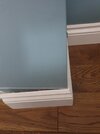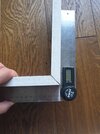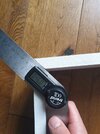- Joined
- 7 Feb 2020
- Messages
- 11
- Reaction score
- 0
- Country

Sorry if something like this has been posted before I couldn't find anything when I searched.
Trying to replace some damage skirting and having a nightmare trying to get the angle right.
As per the pictures I used a digital angle finder to find the external corner. This is showing as 88 degrees. I've the subtracted 88 from 180 which gives me 92 devided by 2 = 46 degrees.
I've then taken this measurement and put it on my angle finder before transferring to the base of the skirting. I've done two 46 degree cuts following the angle I've marked and I'm getting the discrepancy in the second picture. Seems the angle is out by a few degrees if you look at the skirting compared to the wall. I have pushed the skirting into the wall on one side in the second photo as it would sit if it were fixed. My hand saw skills aren't perfect but they are fairly good and I followed the line accurately so I don't think I've messed up in this regard.
Am I doing something wrong or is my angle finder not as accurate as I hoped?
Any help would be much appreciated.

Trying to replace some damage skirting and having a nightmare trying to get the angle right.
As per the pictures I used a digital angle finder to find the external corner. This is showing as 88 degrees. I've the subtracted 88 from 180 which gives me 92 devided by 2 = 46 degrees.
I've then taken this measurement and put it on my angle finder before transferring to the base of the skirting. I've done two 46 degree cuts following the angle I've marked and I'm getting the discrepancy in the second picture. Seems the angle is out by a few degrees if you look at the skirting compared to the wall. I have pushed the skirting into the wall on one side in the second photo as it would sit if it were fixed. My hand saw skills aren't perfect but they are fairly good and I followed the line accurately so I don't think I've messed up in this regard.
Am I doing something wrong or is my angle finder not as accurate as I hoped?
Any help would be much appreciated.



